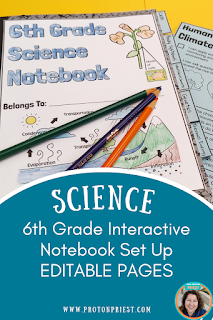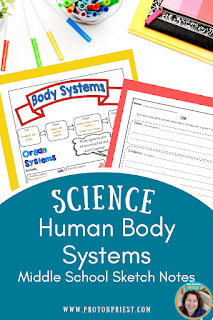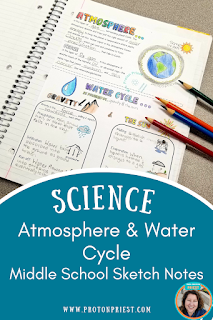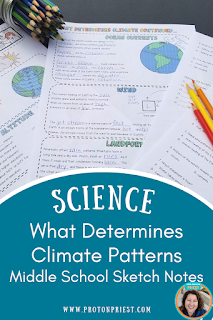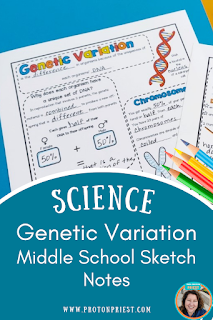Do you want to know how you can use 6th grade science sketch notes to increase science learning while making your life easier? Science sketch notes combine words and images which increases students' ability to retain information.
Note: scroll to the bottom of the page to get a sketch note FREEBIE to try out.
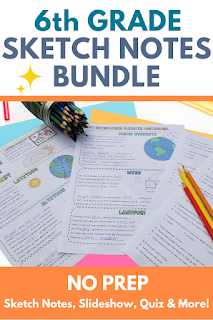 |
| Interested in the 6th grade bundle? Click HERE to see on TPT |
Interactive notebooks are notebooks that students use to document their learning and exploration in science. These interactive science notebooks are an ideal place to incorporate science sketch notes. Sketch notes are engaging and help meet the needs of all learners in class by making science concepts easy to understand with simple graphics and clear explanations. Most of the sketch notes include slideshows, writing prompts, and digital and print quizzes.
6 Benefits of Sketch Notes
1. Organizing Information
Sketch notes help students organize information in a clear and structured way. Challenging concepts are more easily understood when they are visually mapped out with simple graphics and explanations.
2. Improves Comprehension
Science sketch notes can help students understand complex topics by breaking them into manageable pieces. Students can see how concepts fit together and examples in action.
3. Enhances Creativity
Middle school science students can add their own spin to their sketch notes. Adding different colors with markers or colored pencils helps students make the notes their own and engage with the concepts. Areas of the notes encourage students to explain what they have learned or provide a real-world example of the concept.
4. Supports Review and Studying
By reviewing their science sketch notes, students can reinforce their understanding of key concepts and prepare for tests and assessments.
5. Teacher Time Saver
In addition to being a helpful resource for students, science sketch notes can also be a time-saver for teachers. With low-prep activities, quizzes, and slideshows included in the notes, teachers can spend less time creating lesson plans and more time focusing on teaching.
6. Standards Aligned
Science sketch notes are aligned with the 6th grade NGSS (Next Generation Science Standards), which means they cover the topics and skills that students are expected to learn at this grade level. This makes them an excellent tool for teachers who want to ensure that they are meeting curriculum standards and preparing their students for future science courses.
6 Tips on How to Use Sketch Notes
- Print and time the sketch notes pages and give each student a copy
- Show the slideshow to the whole class and fill out the notes together
- Students who need a little extra help: provide a copy of completed notes for them to use to fill out their page
- Post the slideshow on Google Classroom on your LMS so students who are absent can access them. Many of my students like to use the slideshow for studying
- Go over the notes using a variety of methods. Give the print or digital quiz. I love using the self-grading quiz because it makes life easier!
- Help students not lose their work by keeping sketch notes in an interactive science notebook
16 Resources for 6th Grade Science
The following sketch notes sets are for 6th grade science and include a slideshow and quiz. Many also have CER writing prompts.
These resources are organized by middle school science topic below.
Ready to see the 6th-grade science sketch notes bundle? Click HERE
2 Resources to Introduce 6th Grade Science
1. 6th Grade Editable Unit Covers and Notebook Set Up
3 Resources to Introduce Cells
3. Organisms are Made of Cells (notes, quiz)
- Organisms are living things like plants, animals, and single-celled organisms
- Organisms are made of structures
- Cells are the smallest structural and functional unit of all living things.
- Cells are made of organelles
4. Prokaryotic and Eukaryotic Cells and Organelles MS LS1-2 (notes, quiz, slideshow, CER)
5. Diffusion and Osmosis (notes, activities, slideshow)
6. Human Body Systems MS LS1-3 (notes, quiz, slideshow)
This one-page human body systems page of notes comes with the option to include six or eleven body systems. A slideshow guides students as they fill out the notes.
One page graphic organizer with six human body systems includes:
- Circulatory System
- Respiratory System
- Muscular System
- Excretory System
- Digestive System
- Nervous System
One-page graphic organizer with 11 human body systems includes:
- 6 systems above as well as the
- Reproductive System
- Skeletal System
- Immune System
- Integumentary Systems
- Endocrine System
4 Resources on Weather and Climate
7. Atmosphere and Water Cycle MS ESS2-5 (notes, quiz)
8. Air Masses and Weather Fronts MS ESS2-5 (notes, quiz, ppt)
9. What Determines Climate Patterns MS ESS2-6 (notes, quiz, slideshow)
Click HERE to see the preview on TPT
2 Resources on Energy
11. Kinetic and Potential Energy MS PS3-1, MS PS3-5 (notes quiz, slideshow)
12. Thermal Energy Transfer MS PS3-4 (notes, quiz, slideshow)
13. Environmental and Genetic Factors Influencing Growth MSS LS1-5 (notes, quiz, slideshow)
Click HERE to see the preview on TPT
14. Genetic Variation MS LS3-2 (notes, quiz, slideshow)
15. Sexual and Asexual Reproduction MS LS1-4 (notes, quiz, slideshow)
16. Human Activities and Global Climate Change MS ESS3-5 (notes, quiz, slideshow, CER)
Click HERE to see the preview on TPT
To Recap: 6th Grade Science Sketch Notes
- are low prep
- are engaging and simple visual notes
- great for all types of learners
- include slideshows and quizzes
- time savers for teachers

